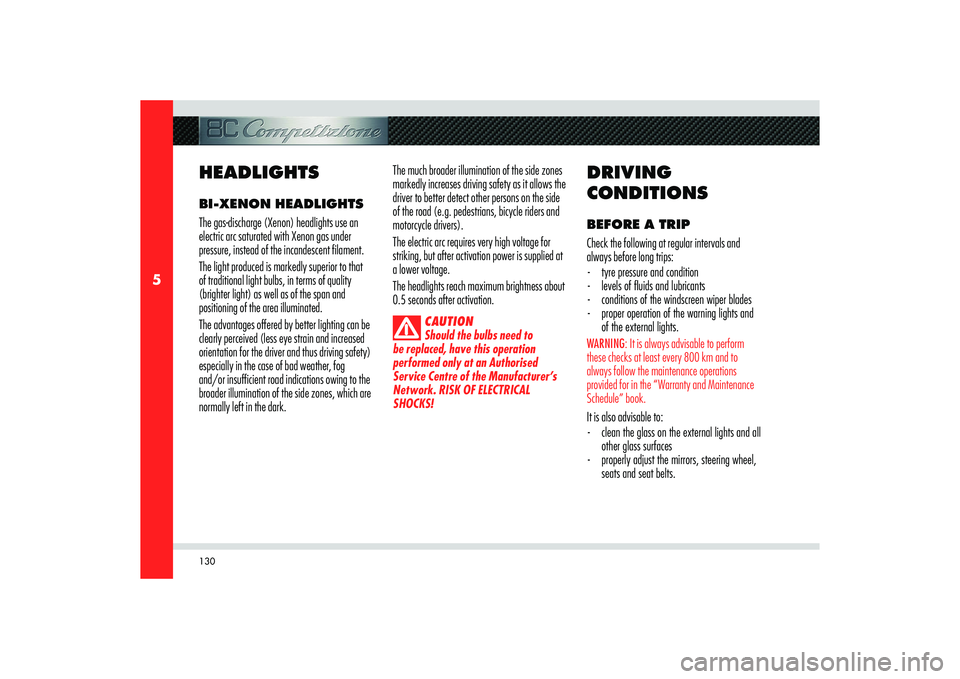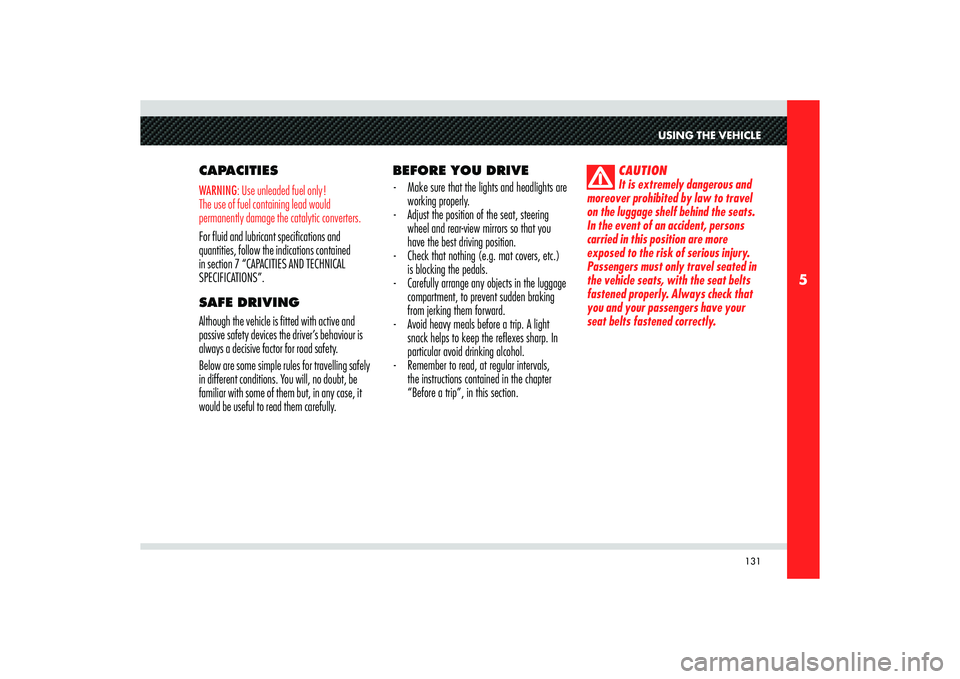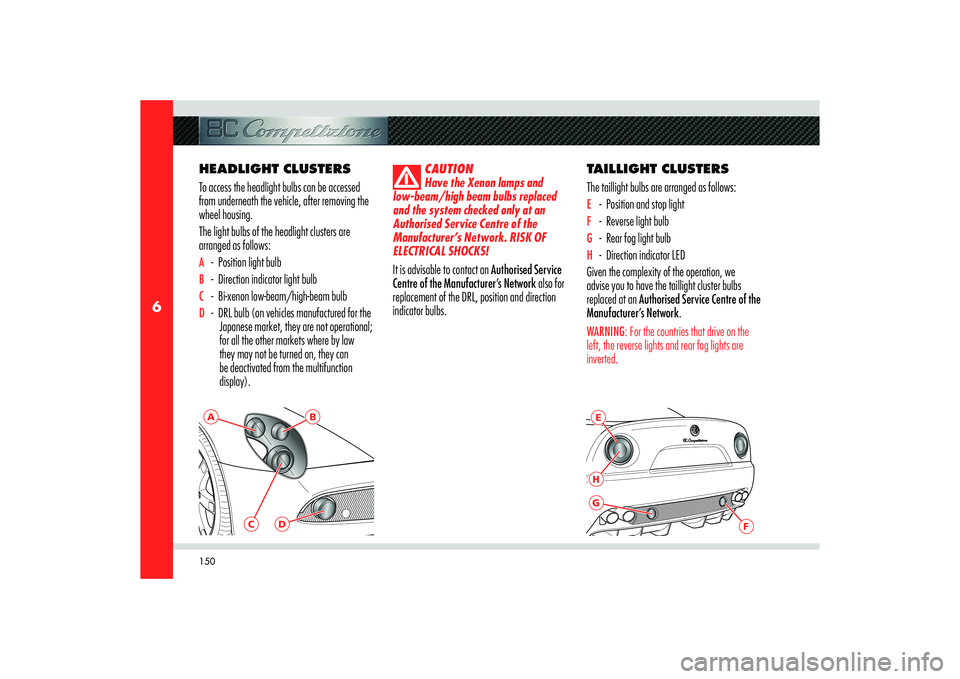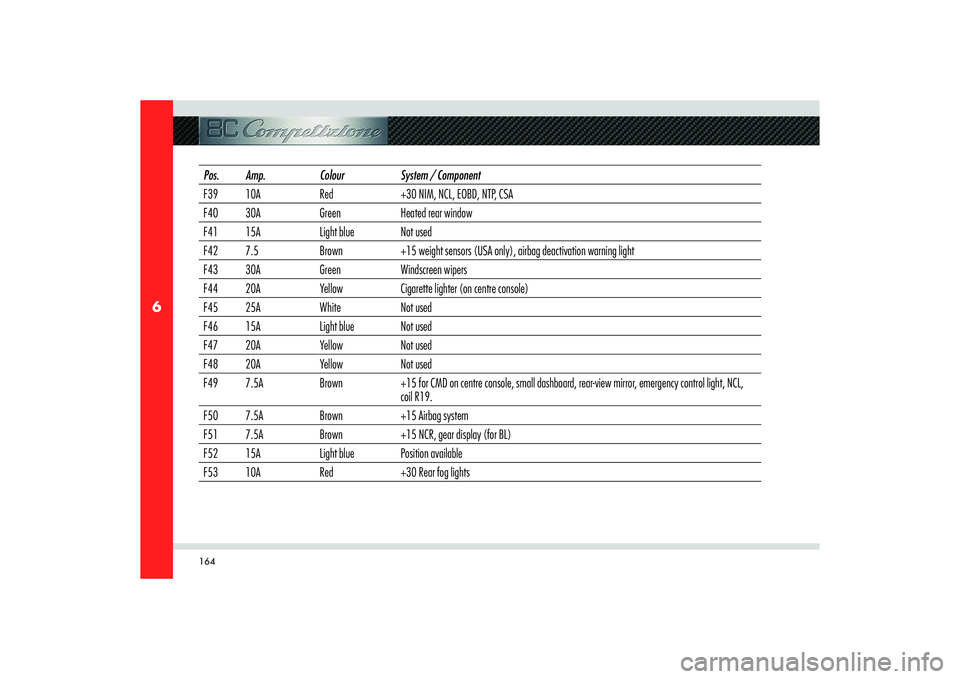warning lights Alfa Romeo 8C 2010 Owner handbook (in English)
[x] Cancel search | Manufacturer: ALFA ROMEO, Model Year: 2010, Model line: 8C, Model: Alfa Romeo 8C 2010Pages: 223, PDF Size: 14.35 MB
Page 132 of 223

130
5
HEADLIGHTSBI-XENON HEADLIGHTS
The gas-discharge (Xenon) headlights use an
electric arc saturated with Xenon gas under
pressure, instead of the incandescent filament.
The light produced is markedly superior to that
of traditional light bulbs, in terms of quality
(brighter light) as well as of the span and
positioning of the area illuminated.
The advantages offered by better lighting can be
clearly perceived (less eye strain and increased
orientation for the driver and thus driving safety)
especially in the case of bad weather, fog
and/or insufficient road indications owing to the
broader illumination of the side zones, which are
normally left in the dark.The much broader illumination of the side zones
markedly increases driving safety as it allows the
driver to better detect other persons on the side
of the road (e.g. pedestrians, bicycle riders and
motorcycle drivers).
The electric arc requires very high voltage for
striking, but after activation power is supplied at
a lower voltage.
The headlights reach maximum brightness about
0.5 seconds after activation.
CAUTION
Should the bulbs need to
be replaced, have this operation
performed only at an Authorised
Service Centre of the Manufacturer’s
Network. RISK OF ELECTRICAL
SHOCKS!
DRIVING
CONDITIONSBEFORE A TRIP
Check the following at regular intervals and
always before long trips:
- tyre pressure and condition
- levels of fl uids and lubricants
- conditions of the windscreen wiper blades
- proper operation of the warning lights and
of the external lights.WARNING: It is always advisable to perform
these checks at least every 800 km and to
always follow the maintenance operations
provided for in the “Warranty and Maintenance
Schedule” book.It is also advisable to:
- clean the glass on the external lights and all
other glass surfaces
- properly adjust the mirrors, steering wheel,
seats and seat belts.
Page 133 of 223

131
5
USING THE VEHICLE
CAPACITIESWARNING: Use unleaded fuel only!
The use of fuel containing lead would
permanently damage the catalytic converters.For fluid and lubricant specifications and
quantities, follow the indications contained
in section 7 “CAPACITIES AND TECHNICAL
SPECIFICATIONS”.
SAFE DRIVING
Although the vehicle is fitted with active and
passive safety devices the driver’s behaviour is
always a decisive factor for road safety.
Below are some simple rules for travelling safely
in different conditions. You will, no doubt, be
familiar with some of them but, in any case, it
would be useful to read them carefully.BEFORE YOU DRIVE
- Make sure that the lights and headlights are
working properly.
- Adjust the position of the seat, steering
wheel and rear-view mirrors so that you
have the best driving position.
- Check that nothing (e.g. mat covers, etc.)
is blocking the pedals.
- Carefully arrange any objects in the luggage
compartment, to prevent sudden braking
from jerking them forward.
- Avoid heavy meals before a trip. A light
snack helps to keep the refl exes sharp. In
particular avoid drinking alcohol.
- Remember to read, at regular intervals,
the instructions contained in the chapter
“Before a trip”, in this section.
CAUTION
It is extremely dangerous and
moreover prohibited by law to travel
on the luggage shelf behind the seats.
In the event of an accident, persons
carried in this position are more
exposed to the risk of serious injury.
Passengers must only travel seated in
the vehicle seats, with the seat belts
fastened properly. Always check that
you and your passengers have your
seat belts fastened correctly.
Page 135 of 223

133
5
USING THE VEHICLE
- Use the high beams only outside of urban
areas and when you are sure that they will
not disturb other drivers.
- When another vehicle is approaching,
switch the high beams (if on) to low
beams.
- Keep the lights and headlights clean.
- Outside urban areas, beware of animals
crossing the road. DRIVING IN THE RAIN
Rain and wet roads are dangerous. On a wet
road all the manoeuvres are more difficult since
wheel grip on the asphalt is significantly reduced.
This means that the braking distances increase
considerably and the road holding decreases.
Certain advice for driving in the rain follows:
- Reduce your speed and keep a greater
safety distance from the vehicles in front
of you. High speed may result in a loss of
control and aquaplaning.
- Heavy rain also substantially reduces
visibility.
- Set the Air Conditioning controls to
demisting, in order to avoid any visibility
problems.
- Periodically check the conditions of the
windscreen wiper blades. DRIVING IN FOG
If the fog is dense avoid travelling where
possible.
When driving in mist, blanket fog or when there
is the possibility of banks of fog:
- Keep a moderate speed.
- Turn on the rear fog lights. Do not use the
main beam.
- Remember that fog creates dampness on
the asphalt and thus any type of manoeuvre
is more diffi cult and braking distances are
greater.
- Keep a safe distance from the vehicle in
front of you.
- Avoid sudden changes in speed as much as
possible.
- Whenever possible, avoid passing other
vehicles.
- If you are forced to stop the vehicle
(breakdowns, impossibility of proceeding
due to poor visibility, etc.), fi rst of all, try to
stop off of the travel lane. Then turn on the
hazard warning lights and if possible, the
low beams.
Page 148 of 223

146
6
EMERGENCY
STARTINGIf the Alfa Romeo CODE fails to deactivate the
engine immobilizer, the CODE
warning light
will illuminate permanently, while the EOBD
warning light will go off after four seconds
to turn on again immediately afterwards: the
engine will not start. To start the engine, it is
necessary to follow the emergency starting
procedure.
WARNING: We recommend that you carefully
read the entire procedure before performing it.
If you make a mistake, turn the ignition key to
STOP and repeat the operations from step 1.1) Read the 5-digit electronic code found on
the CODE CARD.
2) Turn the ignition key to MAR: at this
moment the CODE
and EOBD
warning lights are on.
3) Depress the accelerator pedal and hold
it down. Approximately 8 seconds later,
the EOBD warning light will go off.
Release the accelerator and get ready to
count the number of times the EOBD warning light fl ashes.
4) As soon as the number of fl ashing is equal
to the fi rst digit of your CODE CARD, fully
depress the accelerator pedal and hold it
down until the EOBD warning light
goes off (after approximately 4 seconds).
You can now release the accelerator pedal.
5) The EOBD warning light starts fl ashing
again. As soon as the displayed number of
fl ashing is equal to the second digit of your
CODE CARD, depress the accelerator and
hold it down.
6) Follow the same procedure for the
remaining digits in the code on the CODE
CARD.
7) When the last digit has been entered, keep
the accelerator pedal pressed down. The
EOBD warning light comes on for 4
seconds and then goes off. You can now
release the accelerator pedal.
8) A quick fl ashing of the EOBD warning
light (about 4 seconds) confi rms that
procedure has been carried out correctly.
9) Start the engine by pressing the START
button while holding the brake pedal
depressed.If the EOBD warning light remains on,
turn the key to position STOP and repeat the
procedure from step 1.
This procedure can be repeated an unlimited
number of times.
WARNING: After an emergency staring, you
should contact an Authorised Service Centre of
the Manufacturer’s Network as the emergency
starting procedure will have to be carried out
every time you start the vehicle.
Page 152 of 223

150
6
E
F
HG
A
B
C
D
HEADLIGHT CLUSTERS
To access the headlight bulbs can be accessed
from underneath the vehicle, after removing the
wheel housing.
The light bulbs of the headlight clusters are
arranged as follows:A - Position light bulb B - Direction indicator light bulbC - Bi-xenon low-beam/high-beam bulbD - DRL bulb (on vehicles manufactured for the
Japanese market, they are not operational;
for all the other markets where by law
they may not be turned on, they can
be deactivated from the multifunction
display).
CAUTION
Have the Xenon lamps and
low-beam/high beam bulbs replaced
and the system checked only at an
Authorised Service Centre of the
Manufacturer’s Network. RISK OF
ELECTRICAL SHOCKS!
It is advisable to contact an Authorised Service
Centre of the Manufacturer’s Network also for
replacement of the DRL, position and direction
indicator bulbs.
TAILLIGHT CLUSTERS
The taillight bulbs are arranged as follows:E - Position and stop lightF - Reverse light bulbG - Rear fog light bulbH - Direction indicator LED
Given the complexity of the operation, we
advise you to have the taillight cluster bulbs
replaced at an Authorised Service Centre of the
Manufacturer’s Network.WARNING: For the countries that drive on the
left, the reverse lights and rear fog lights are
inverted.
Page 153 of 223

151
6
2
1
K
J
L
M
IN AN EMERGENCY
DIRECTION INDICATOR
LIGHTS
To replace the direction indicator light bulb (5W):
1) Push the direction indicator forward to
compress the spring clip
J. 4) Remove the bulb
M and replace it.
5) Refi t the bulb holder turning it clockwise.
6) Refi t the direction indicator inserting fi rst
the retaining tab on the rear part and then
pressing the front part until hearing the
spring clip click into position.
WARNING: Proceed with care when removing
the side direction indicator light to avoid
damages to the vehicle body or to the indicator
itself.
2) Remove the rear part of the indicator by
releasing the catch
K and remove the unit.
3) Remove the bulb holder L by turning it
anticlockwise.
Page 166 of 223

164
6
Pos. Amp. Colour System / Component
F39 10A Red +30 NIM, NCL, EOBD, NTP, CSA
F40 30A Green Heated rear window
F41 15A Light blue Not used
F42 7.5 Brown +15 weight sensors (USA only), airbag deactivation warning light
F43 30A Green Windscreen wipers
F44 20A Yellow Cigarette lighter (on centre console)
F45 25A White Not used
F46 15A Light blue Not used
F47 20A Yellow Not used
F48 20A Yellow Not used
F49 7.5A Brown +15 for CMD on centre console, small dashboard, rear-view mirror, emergency control light, NCL,
coil R19.
F50 7.5A Brown +15 Airbag system
F51 7.5A Brown +15 NCR, gear display (for BL)
F52 15A Light blue Position available
F53 10A Red +30 Rear fog lights
Page 173 of 223

171
6
IN AN EMERGENCY
IN THE EVENT OF
AN ACCIDENT It is important always to stay calm.
- If you are not directly involved, stop at a
distance of at least ten metres away from
the accident area.
- If you are on a highway, stop without
obstructing the emergency lane.
- Turn off the engine and turn on the hazard
warning lights.
- At night, illuminate the accident area with
the headlights.
- Always act with caution: you should not risk
someone crashing into you.
- Indicate that an accident has occurred
by placing the emergency triangle in a
well visible position and at the prescribed
distance.
- Call the emergency services, providing as
much information as possible. On highways,
use the special emergency call boxes.
- Remove the ignition key from the vehicles
involved.
- If you smell fuel or other chemical products,
do not smoke and ask people around you to put their cigarettes out.
To extinguish fires, even small ones, use a fire
extinguisher, blankets, sand or earth. Never use
water.
In multiple accidents occurred on highways,
particularly where visibility is poor, there is a
high risk of being involved in other collisions.
Leave your vehicle immediately and move away
from it. IF THERE ARE INJURED
PERSONS
- Never leave an injured person alone.
Persons not directly involved in the accident
are also required to give assistance.
- Do not crowd around injured persons.
- Reassure the injured person that aids are on
the way and stay close to them to help with
possible panic attacks.
- Unfasten or cut the seat belts restraining
the injured persons.
- Do not give the injured persons anything to
drink.
- The injured person should never be moved.
- Remove the injured person from the vehicle
only if there is a risk of fi re, sinking in water
or falling down into a pit. When removing
an injured person, do not pull his/her limbs,
bend his/her head and, as far as possible,
keep the body in a horizontal position.
Page 200 of 223

198
8
A
B
C
BATTERYThe battery is of the “low maintenance” type,
and is located on the right side of the luggage
compartment
To access the battery lift the shelf and
A and the
box cover
B releasing the hooks.
C.
With the vehicle standing on a flat surface, the
battery fluid level (electrolyte) must be between
the MIN and MAX reference notches shown on
the battery.
If the level is lower than the MIN reference
notch, contact an Authorised Service Centre
of the Manufacturer’s Network to have it
checked.To recharge the battery, see the section “In an
emergency”.
CAUTION
The fluid contained in the
battery is poisonous and corrosive.
Avoid contact with the skin and eyes.
Do not approach the battery with open
flames or possible sources of sparks:
risk of explosion and fire!
Batteries contain substances that are very
harmful for the environment. We advise you
to have the battery replaced at an Authorised
Service Centre of the Manufacturer’s
Network, where all the necessary equipment
is available to dispose of the used parts in compliance with applicable legislation and in an
environment-friendly manner.
WARNING: Incorrect assembly of electrical and
electronic accessories can cause serious damage
to the vehicle.USEFUL HINTS FOR
EXTENDING THE LIFE OF
THE BATTERY
When parking the vehicle, make sure that the
doors, luggage and engine compartment lids
are properly closed. All interior lights should be
off. When the engine is off, do not keep the
connected devices switched on for a long time
(for example the radio, the hazard warning
lights, the fan, etc.).
Page 211 of 223

209
8
MAINTENANCE
Always first disconnect the power cable from
the mains and then disconnect the battery
conditioner from the vehicle socket. WARNING: The vehicle cannot be started as
long as the battery conditioner is connected to
the vehicle socket (even when it is disconnected
from the mains).When the warning light (1) is on permanently: it
means that there is an electric system fault in the
vehicle or the battery.
When the warning light (2) is on permanently:
it means that the battery conditioner is in the
“Active” phase. During this phase the battery
is recharged to the optimal charge level, from a
lower one.
When the warning light (3) is on permanently:
it means that the battery is fully charged and the
battery conditioner is in the “Passive” phase.
During this phase, the device maintains the
battery at an optimal charge level.
When the warning lights (2 and 3) are on and
flash alternately:
- if the warning lights fl ash a few times a
second, it means that the battery may be
sulphated. - if the warning lights fl ash alternately for
more than 60 minutes, it means that the
battery must be replaced.
- if the warning lights fl ash at intervals of a
few minutes, it means that the battery self-
discharge percentage is high and it might
have to be replaced.
When no warning light is on, the following may
have occurred:
- the battery conditioner cables may be
disconnected;
- the battery may not be properly connected
to the vehicle system;
- the battery may be defective;- the battery voltage may be low or there
may be a lack of power on the mains
socket.
1- error warning light
2- active phase warning light: signalling
3- maintenance warning light: maintenance
After checking the connection of the battery
conditioner (both to the mains and the vehicle
socket) and that the mains are powered, if
the (2 or 3) “Active” and “Passive” phase
warning lights do not illuminate a few seconds
after connecting the battery conditioner,
contact an Authorised Service Centre of the
Manufacturer’s Network to have the electric
system of the vehicle checked.
1
2
3